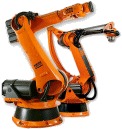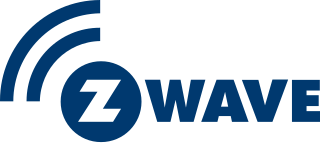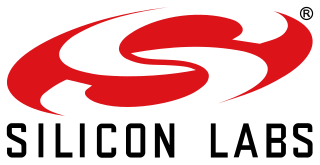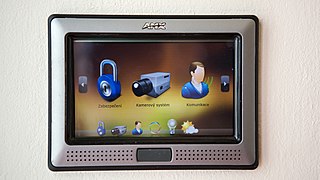
Home automation or domotics is building automation for a home, called a smart home or smart house. A home automation system will monitor and/or control home attributes such as lighting, climate, entertainment systems, and appliances. It may also include home security such as access control and alarm systems. When connected with the Internet, home devices are an important constituent of the Internet of Things ("IoT").
Zigbee is an IEEE 802.15.4-based specification for a suite of high-level communication protocols used to create personal area networks with small, low-power digital radios, such as for home automation, medical device data collection, and other low-power low-bandwidth needs, designed for small scale projects which need wireless connection. Hence, Zigbee is a low-power, low data rate, and close proximity wireless ad hoc network.

Z-Wave is a wireless communications protocol used primarily for residential and commercial building automation. It is a mesh network using low-energy radio waves to communicate from device to device, allowing for wireless control of smart home devices, such as smart lights, security systems, thermostats, sensors, smart door locks, and garage door openers. Like other protocols and systems aimed at the residential, commercial, MDU and building markets, a Z-Wave system can be controlled from a smart phone, tablet, or computer, and locally through a smart speaker, wireless keyfob, or wall-mounted panel with a Z-Wave gateway or central control device serving as both the hub or controller. Z-Wave provides the application layer interoperability between home control systems of different manufacturers that are a part of its alliance. There is a growing number of interoperable Z-Wave products; over 1,700 in 2017, over 2,600 by 2019, and over 4,000 by 2022.
A universal remote is a remote control that can be programmed to operate various brands of one or more types of consumer electronics devices. Low-end universal remotes can only control a set number of devices determined by their manufacturer, while mid- and high-end universal remotes allow the user to program in new control codes to the remote. Many remotes sold with various electronics include universal remote capabilities for other types of devices, which allows the remote to control other devices beyond the device it came with. For example, a VCR remote may be programmed to operate various brands of televisions.

A home network or home area network (HAN) is a type of computer network that facilitates communication among devices within the close vicinity of a home. Devices capable of participating in this network, for example, smart devices such as network printers and handheld mobile computers, often gain enhanced emergent capabilities through their ability to interact. These additional capabilities can be used to increase the quality of life inside the home in a variety of ways, such as automation of repetitive tasks, increased personal productivity, enhanced home security, and easier access to entertainment.

Continua Health Alliance is an international non-profit, open industry group of nearly 240 healthcare providers, communications, medical, and fitness device companies. Continua Health Alliance members aim to develop a system to deliver personal and individual healthcare. Continua was a founding member of Personal Connected Health Alliance which was launched in February 2014 with other founding members mHealth SUMMIT and HIMSS.
Ember was an American company based in Boston, Massachusetts, USA, which is now owned by Silicon Labs. Ember had a radio development centre in Cambridge, England, and distributors worldwide. It developed ZigBee wireless networking technology that enabled companies involved in energy technologies to help make buildings and homes smarter, consume less energy, and operate more efficiently. The low-power wireless technology can be embedded into a wide variety of devices to be part of a self-organizing mesh network. All Ember products conform to IEEE 802.15.4-2003 standards.

Silicon Laboratories, Inc. is a fabless global technology company that designs and manufactures semiconductors, other silicon devices and software, which it sells to electronics design engineers and manufacturers in Internet of Things (IoT) infrastructure worldwide.

An RF module is a (usually) small electronic device used to transmit and/or receive radio signals between two devices. In an embedded system it is often desirable to communicate with another device wirelessly. This wireless communication may be accomplished through optical communication or through radio-frequency (RF) communication. For many applications, the medium of choice is RF since it does not require line of sight. RF communications incorporate a transmitter and a receiver. They are of various types and ranges. Some can transmit up to 500 feet. RF modules are typically fabricated using RF CMOS technology.

GreenPeak Technologies was an Utrecht, Netherlands-based fabless company developing semiconductor products and software for the IEEE 802.15.4 and ZigBee wireless market segment. ZigBee technology is used for Smart Home data communications and to facilitate the Internet of Things, the term used to refer to devices designed to be operated and managed by internet-enabled controllers and management systems.
DECT Ultra Low Energy is a wireless communication standard used to design wireless sensor and actuator networks for smart home applications. DECT ULE originated from the DECT and NG-DECT (Cat-iq) technology. DECT ULE devices are used in home automation, home security, and climate control.

This is a list of home automation topics on Wikipedia. Home automation is the residential extension of building automation. It is automation of the home, housework or household activity. Home automation may include centralized control of lighting, HVAC, appliances, security locks of gates and doors and other systems, to provide improved convenience, comfort, energy efficiency and security.
Thread is an IPv6-based, low-power mesh networking technology for Internet of things (IoT) products. Thread is reliable, secure and delivers fast response times, extended coverage and years of battery life to elevate smart home and building experiences. The Thread protocol specification is available at no cost; however, this requires agreement and continued adherence to an End-User License Agreement (EULA), which states that "Membership in Thread Group is necessary to implement, practice, and ship Thread technology and Thread Group specifications."

Logitech Harmony is a line of remote controls and home automation products produced by Logitech. The line includes universal remote products designed for controlling the components of home theater systems and other devices that can be controlled via infrared, as well as newer smart home hub products that can be used to additionally control supported Internet of things (IoT) and Smart home products, and allow the use of mobile apps to control devices. On April 10, 2021, Logitech announced that they would discontinue Harmony Remote manufacturing.

Wink is an American brand of software and hardware products that connects with and controls smart home devices from a consolidated user interface. Wink, Labs Inc., which develops and markets Wink, was founded in 2014 as a spin-off from invention incubator Quirky. After Quirky went through bankruptcy proceedings, it sold Wink to Flex in 2015. As of 2016, the Wink software is connected to 1.3 million devices. In July 2017, Flex sold Wink to i.am+ for $59M.

Philips Hue is a line of color-changing LED lamps and white bulbs which can be controlled wirelessly. The Phillips Hue line of bulbs was the first smart bulb of its kind on the market. The lamps are currently created and manufactured by Signify N.V., formerly the Philips Lighting division of Royal Philips N.V.

Matter, formerly Project Connected Home over IP (CHIP), is a royalty-free home automation connectivity standard, with manufacturers only incurring certification costs. Announced on December 18, 2019, Matter aims to reduce fragmentation across different vendors, and achieve interoperability among smart home devices and Internet of things (IoT) platforms from different providers. The project group was launched and introduced by Amazon, Apple, Google, Comcast and the Zigbee Alliance, now Connectivity Standards Alliance (CSA). Subsequent members include IKEA, Huawei, and Schneider. Matter-compatible products and software updates for existing products are expected to be released in 2022. Although the Matter code repository is open-source under the Apache license, the Matter specification is licensed by CSA.

Home Assistant is a free and open-source software for home automation designed to be a central control system for smart home devices with a focus on local control and privacy. It can be accessed through a web-based user interface using companion apps for Android and iOS, or by voice commands via a supported virtual assistant such as Google Assistant, Amazon Alexa or even "Genie" by Stanford Open Virtual Assistant Lab (OVAL.)

Develco Products is a B2B wireless technology producer, headquartered in Aarhus, Denmark. The company was established in 2007 and develops white label devices for B2C solution providers and has over 3,000,000 devices deployed worldwide... Their main business areas are home care, security, InsurTech, and smart energy. They are a member of the Connectivity Standards Alliance as their main technological expertise lies in Zigbee-based devices that communicate through a mesh network. The company claims their most popular product is the Squid.link gateway.
A smart home hub, sometimes also referred to as a "smart hub", "gateway'", "bridge", "controller" or "coordinator", is a control center/centre for a smart home, and enables the components of a smart home to communicate and respond to each other via communication through a central point. The smart home hub can consist of dedicated computer appliance, software appliance, or software running on computer hardware, and makes it possible to gather configuration, automation and monitoring of a smart house by communicating and controlling different smart devices that consistans for example home appliances, sensors and relays or robots, many of which are commonly categorized under Internet of things.












